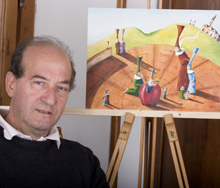Ricerca Veloce
Ricerca Avanzata

Walter Bini
Il pittore fiorentino Walter Bini (Firenze, 1948-2009) ha sviluppato una tematica pittorica propria, inventando un genere, definito surreale fantastico, partendo dall’ironia di scene quotidiane i cui protagonisti erano personaggi dai cappelli allungati e gli abiti monastici. Dalle ambientazioni della prima serie, nella Toscana del Trecento, alle successive in luoghi quali la sartoria e il teatro (2005) fino alla rappresentazione, nel 2006, di periodi ed eventi storico-letterari (i bizantini, Montecchi e Capuleti) era imprescindibile nelle sue opere la presenza di simpatici topolini in mise-en-abîme. Inseriti nel quadro come piccoli particolari, in realtà riproducono in modo ironico la scena principale. Gli ambienti trattati in dettaglio evidenziano una singolare accuratezza nella riproduzione delle strutture architettoniche, rese uniche da particolari fantasiosi caratterizzanti dell’artista, e nel sapiente uso delle luci. In suggestive atmosfere da palcoscenico Bini inseriva, come attori, i suoi personaggi e i loro “topi alter ego”.
La passione e la voglia di ampliare questo mondo fantastico lo portarono a realizzare la mostra Tele a Colori, presso lo Showroom Bertocci di Firenze (2004), a cui sono seguirno varie partecipazioni a importanti collettive, tra cui la decima edizione di Individuazioni, presso la Galleria Mentana di Firenze (2005), la Rassegna arti visive per l’ Associazione Culturale Gadarte presso il fiorentino Palagio di Parte Guelfa e presso la Limonaia di Pescille a Panzano in Chianti (2006) e L’Uomo che fabbrica i sogni, presso la Galleria Art Point Black di Firenze (2006).
Vedi anche...
Favole col cappello di Zia Birò
- € 10,12
- € 11,90
